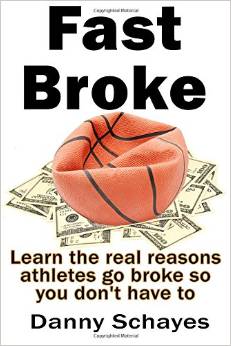 We have all heard about the alarming statistics indicating that most professional athletes will be broke within five to seven years of retirement.
We have all heard about the alarming statistics indicating that most professional athletes will be broke within five to seven years of retirement.
And we all ask the same questions.
“How can this happen when they make all that money?”
“Who is advising these guys?”
“Where is their agent?”
“Why doesn’t the league do something?”
Plus we have all heard the stories about the extravagant spending, the children out of wedlock, the bad investments and wonder, “How dumb can these guys be?”
The answer is much simpler than you think.
And while we vicariously enjoy hearing the stories of the wild nightclub parties, the garages with six luxury cars and the necklaces with enough jewels to be seen from space, it is a myth that the sole reason players go broke is because they spend themselves to death. It certainly happens to some guys who spend themselves into the poor house, but they are the exception, not the rule. That is not the root cause of the problem. It is merely one of the symptoms.
 You need to remember that many players come from poor backgrounds. Earlier, we discussed what typically happens when a person from a poor upbringing suddenly gets a huge windfall of cash. We also discussed how the system is designed to separate a player from his money while he is in many ways defenseless to stop it. We analyzed the difference between “Smart Money” and “Dumb Money” and how that distinction affects the players’ outcomes.
You need to remember that many players come from poor backgrounds. Earlier, we discussed what typically happens when a person from a poor upbringing suddenly gets a huge windfall of cash. We also discussed how the system is designed to separate a player from his money while he is in many ways defenseless to stop it. We analyzed the difference between “Smart Money” and “Dumb Money” and how that distinction affects the players’ outcomes.
But you can see how, with the proper intervention and training, many of the outlandish behaviors can be controlled. Will that solve the problem? Is it that easy to lower the player failure rate to near zero? Hardly.
It is time to look at the major cause of financial failure in the sports world – and in your world as well. We are going to do this by modeling a player’s financial career and showing the slippery slope that leads to financial failure. At the end, it will be easy to see not only how quickly someone can go through a fortune of earnings, but also how it is practically inevitable.
Our fictitious player is “one of the smart ones.” He realizes that he wants to spend appropriately and doesn’t make any of the ridiculous purchases that are in the headlines. There is no zoo in his backyard, no Ferraris in his garage and no jewelry store in his master bedroom. He doesn’t have a restaurant with his name on it. He does help his family, since his parents sacrificed everything working two jobs to get him to college. He has a couple of lifelong friends who helped him navigate the streets of his hometown, keeping him away from the gangs and the drug dealers so he could make it. Now that he has hit the big time, he will take care of them, but in a modest way. He is married with two kids and wants them to have all of the things that he never could provide otherwise, appropriate for his earning level. But he does not have a second family, an ex-wife or other personal money-draining relationships. In every way he did things the “right” way.
However, he is not a sophisticated investor and does not have any real investments. His major strategy is “don’t screw it up”. He is an excellent saver and puts his money in the bank.
If you think that $5 million, $20 million or even $100 million is a ticket to a lifetime free of financial woes, think again. If you come from a background where there wasn’t much money at all, you might spend and spend and believe the money will never run out. It will. If you come from a background of scarcity, where money was saved, you might think that the savings will provide a secure existence. It won’t. The lower return you get from your money, the lower your lifestyle will be. And the opposite is true as well. The higher return you get from your money, the higher your lifestyle can be.
One hundred million dollars sounds like an enormous amount of money. And it is. But what seems like an inexhaustible fortune can disappear all too fast. How can a person go broke on $100 million? It’s all too easy to do. Let’s use the popular example of the highly paid athlete. He finally gets that wonderful 10-year contract for $100 million. Here’s how his money could evaporate. As you look this over, remember that I am actually being pretty conservative. To understand this, you have to start thinking like someone who believes his money is unlimited. He is not a business executive, attorney or any other type of professional. And the truth is that being a professional doesn’t guarantee any type of financial success. For example, doctors are historically known to be terrible investors. Being smart at one thing doesn’t mean you have the specific knowledge to be smart or successful at a different specialty activity such as investing.
But let’s look at the math.
The first lesson everyone learns with their initial paycheck is the difference between gross and net. The gross is the gigantic amount reported by the media when an athlete signs a new contract. He gets his first monstrous paycheck and sees all of the items automatically deducted from it. We all know that this is the money that we never get, as it goes right to our biggest business partner, the taxman. He gets all of the money you would pay in a divorce but never leaves you alone. He gets half of every paycheck, forever. And no matter how much you pay him, 98 percent of the rest of the world believes you should pay more. So don’t expect your share to go down very often. The forces of government only push up.
So let’s start with our figure of $100,000,000 over 10 years:
– $39,000,000 goes to federal taxes
– $7,000,000 goes to state taxes
– $1,450,000 goes to Medicare tax
– $4,000,000 goes to an agent (4% of gross earnings)
– $5,000,000 goes to a manager (5% of earnings)
That leaves $43,550,000- less than half the original amount – and he hasn’t bought anything yet! Keep in mind that this figure does not account for a charitable giving plan or a tithe to a church, so another $10 million (10% of gross earnings) could easily be deducted.
Now let’s examine what 10 years of big lifestyle looks like in some detail. I’ve seen lots of guys live this way and go broke a few years after reaching retirement. This happens not because they are such extravagant spenders, but because they don’t know how to replace income. They build money-eating machines that can’t be turned off and they don’t have the fuel to keep them running. Remember that while this might look like an ostentatious lifestyle to you, it is not when compared to the income level.
To make the math easy to follow, we will assume that he pays for everything in full. Remember, he will earn this money over 10 years so he will be buying all of the items over time. Were he to finance some of the purchases – such as his home – he would still need to theoretically set aside enough money to generate the income to make the ongoing payments. So let’s set that issue aside for now and call it a wash.
The first thing a player usually buys is his dream home. Assuming he is not in Los Angeles or New York, a reasonable figure for this is about $5,000,000. In most big cities, that will get you a really nice home of 8,000 to 10,000 square feet in the nicest area of town. Again, this is a reasonable purchase for a person with a $100 million contract. It is easy to go way above that in some cities. As all professional sports teams are in major cities, the real estate values in the most desirable areas of those cities will easily support this figure.
Rarely, however, does a player play for his hometown team, so he needs to have a home in the town where he plays. Remember, he is conservative, so he spends $3,000,000 on this home. This can get a little complicated as players are traded or switch teams via free agency. I have seen some players end up with nice real estate portfolios by ending up with homes in four cities, since luxury properties sometimes take a while to sell. But for simplicity’s sake, let’s assume the one home.
Of course, for someone in this income bracket, it would be natural to have a vacation home. Let’s add another $2,000,000 for that purchase. Now we have $10,000,000 of empty homes. We need to add another $5,000,000 for the furnishings for three homes. This will include everything that goes into a home: furniture and art, cars, audio and video equipment, jewelry, clothes and other toys. Remember, the stuff needs to be of the same quality as the house. You don’t fill your mansion with stuff from Target and Wal-Mart.
And when on the receiving end of $100 million, even a rather conservative person will have some extravagance in their life, so let’s set aside another $2 million. Keep in mind we are talking about a 10-year period. Subtract another $17,000,000, leaving our player with $26,550,000.
To review, all our $100 million man has done is paid his taxes and set up a couple of places to live. And he has already gone through nearly 75 percent of his contract.
Purchase a copy of Fast Broke from Amazon.com for $14.95.
Danny Schayes is a Director of Business Optimization at Intensity and a leader in the business of professional sports. Schayes frequently advises sports organizations in complex business matters that include contract negotiations, pricing strategy, marketing optimization, and executive leadership. Follow him on Twitter.
EXCERPT I: WHY PLAYERS GO BROKE
EXCERPT II: SMART MONEY VS. DUMB MONEY
EXCERPT III: WHY ATHLETES AND REGULAR PEOPLE DON’T GET IT
MORE COLUMNS FROM DANNY SCHAYES:
FORGET MVP: THESE AWARDS ARE BETTER
WATCHING FRANK KAMINSKY WAS LIKE LOOKING IN THE MIRROR
HOW DANNY SCHAYES RUINED PATRICK EWING POSTER NIGHT
NO SMOOTHING MEANS $90 MILLION SALARY CAP, FISCAL INSANITY
DIVORCE COURT FOR COACHES AND PLAYERS: A MAGIC JOHNSON COACHING TALE
NBA’S PIONEERS DWINDLING FOLLOWING DEATH OF EARL LLOYD